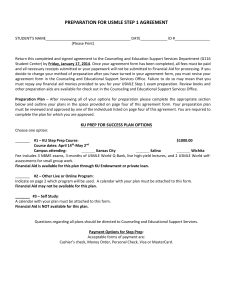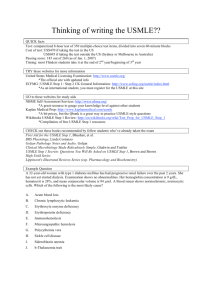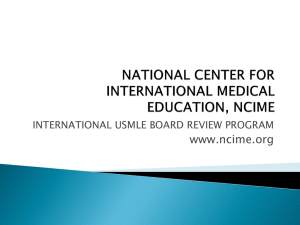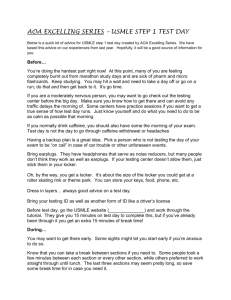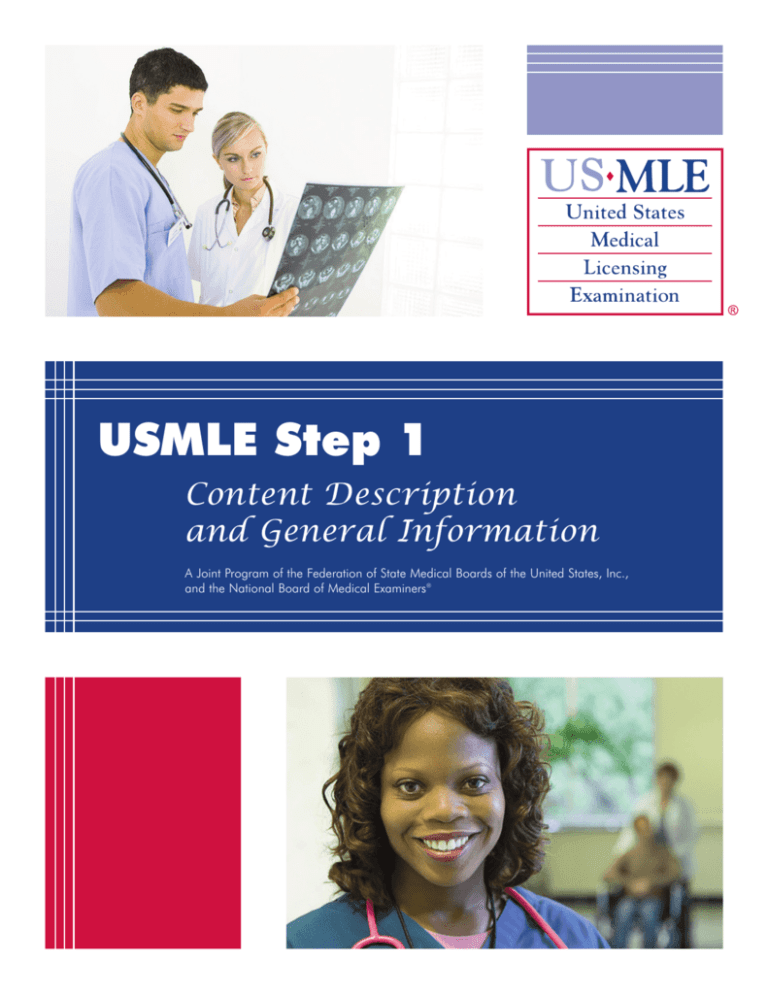
USMLE Step 1
Content Description
and General Information
A Joint Program of the Federation of State Medical Boards of the United States, Inc.,
and the National Board of Medical Examiners®
This booklet updated March 2015.
Copyright © 2015 by the Federation of State Medical Boards of the United States, Inc. (FSMB), and the
National Board of Medical Examiners® (NBME®). All rights reserved. Printed in the United States of
America. The United States Medical Licensing Examination (USMLE®) is a joint program of the FSMB and
the NBME.
1
CONTENTS
Introduction …………………………………………………………..
3
Examination Content …………………………………………………
3
Content Outline ……………………………………………………….
3
Testing Time ………………………………………………………….. 4
Test Specifications ……………………………………………………. 5
2
The test is designed to measure basic science
knowledge. Some questions test the examinee’s
fund of information per se, but the majority of
questions require the examinee to interpret
graphic and tabular material, to identify gross and
microscopic pathologic and normal specimens,
and to solve problems through application of
basic science principles.
Introduction
This booklet is intended to help you prepare for
the Step 1 component of the United States
Medical Licensing Examination® (USMLE®).
The information in this booklet, sample test
materials and tutorials, and other informational
materials are available at the USMLE Web site
(http://www.usmle.org).
Content Outline
In addition to the information in this booklet, you
should review relevant sections of the USMLE
Bulletin of Information.
All USMLE examinations are constructed from
an integrated content outline, available at the
USMLE Web site
(http://www.usmle.org/pdfs/usmlecontentoutline.
pdf), which organizes content according to
general principles and individual organ systems.
Test questions are classified in one of 18 major
areas, depending on whether they focus on
concepts and principles that are important across
organ systems or within individual organ systems.
Sample test materials are available at the USMLE
Web site, in both downloadable computer format,
with tutorials, and as sample items in a booklet.
You must run the tutorial and sample materials to
become familiar with the test software prior to
your test date. The tutorial provided at the
beginning of the Step 1 examination has fewer
screens and less detailed information than the
tutorial available as part of the Step 1 practice
materials on the USMLE Web site.
Sections focusing on individual organ systems are
subdivided according to normal and abnormal
processes, including principles of therapy. Each
Step 1 examination covers content related to the
following traditionally defined disciplines:
In addition, the practice materials on the Web site
include an additional block of items with
associated audio or video findings and a
sequential item set. You should become familiar
with these types of test items before your test
date.
Please monitor the USMLE Web site
(http://www.usmle.org) announcements section to
check for changes in the test delivery software
and to access updated practice materials. You
must obtain the most recent information before
taking any USMLE examination.
anatomy
behavioral sciences
biochemistry
biostatistics and epidemiology
microbiology
pathology
pharmacology
physiology
The Step 1 examination also covers content
related to the following interdisciplinary areas:
Examination Content
Step 1 consists of multiple-choice questions
prepared by examination committees composed
of faculty members, teachers, investigators, and
clinicians with recognized prominence in their
respective fields. Committee members are
selected to provide broad representation from the
academic, practice, and licensing communities
across the United States and Canada.
3
genetics
aging
immunology
nutrition
molecular and cell biology
Step 1 classifies test items along two dimensions,
system and process, as shown in Table 1 (page 5).
While not all topics listed in the content outline
are included in every USMLE examination,
overall content coverage is comparable in the
various examination forms that will be taken by
different examinees for each Step.
emphasis. The categorizations and content
coverage are subject to change. Broadly based
learning that establishes a strong general
understanding of concepts and principles in the
basic sciences is the best preparation for the
examination.
Testing Time
Most organ systems are partitioned into Normal
Processes and Abnormal Processes, and include
subcategories of specific disease processes. In
most instances, knowledge of normal processes is
evaluated in the context of a disease process or
specific pathology.
Step 1 is a one-day examination. You must
complete testing within 8 hours. The testing day
includes 308 multiple-choice items divided into 7
blocks of 44 items; 60 minutes are allotted for
completion of each block of test items. There is a
maximum of 7 hours of testing. There is also a
minimum of 45 minutes of break time and a 15minute optional tutorial. The amount of time
available for breaks may be increased by finishing
a block of test items or the optional tutorial before
the allotted time expires.
The content outline is not intended as a
curriculum development or study guide. It
provides a flexible structure for test construction
that can readily accommodate new topics,
emerging content domains, and shifts in
4
Table 1: USMLE Step 1 Test Specifications*
System
15%-20%
General Principles of Foundational Science**
60%-70%
Immune System
Blood & Lymphoreticular System
Behavioral Health
Nervous System & Special Senses
Skin & Subcutaneous Tissue
Musculoskeletal System
Cardiovascular System
Respiratory System
Gastrointestinal System
Renal & Urinary System
Pregnancy, Childbirth, & the Puerperium
Female Reproductive & Breast
Male Reproductive
Endocrine System
15%-20%
Multisystem Processes & Disorders
Biostatistics & Epidemiology/Population Health
Social Sciences
Process
10%-15%
55%-60%
15%-20%
10%-15%
Normal Processes†
Abnormal Processes
Principles of therapeutics
Other‡
* Percentages are subject to change at any time. See the USMLE Web site (http://www.usmle.org) for the most
up-to-date information.
** The general principles category includes test items concerning those normal and abnormal processes that are
not limited to specific organ systems. Categories for individual organ systems include test items concerning
those normal and abnormal processes that are system-specific.
† This category includes questions about normal structure and function that may appear in the context of an
abnormal clinical presentation.
‡ Approximately 10%-15% of questions are not classified in the normal processes, abnormal processes, or
principles of therapeutics categories. These questions are likely to be classified in the general principles,
biostatistics/evidence-based medicine, or social sciences categories in the USMLE Content Outline.
5

